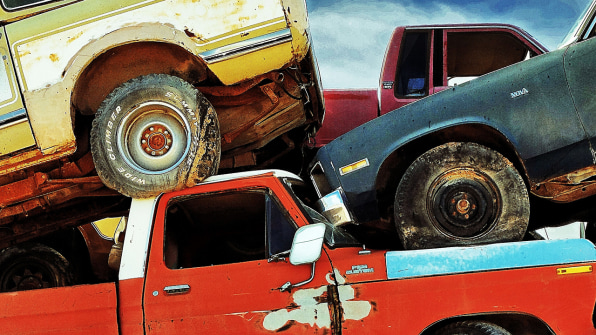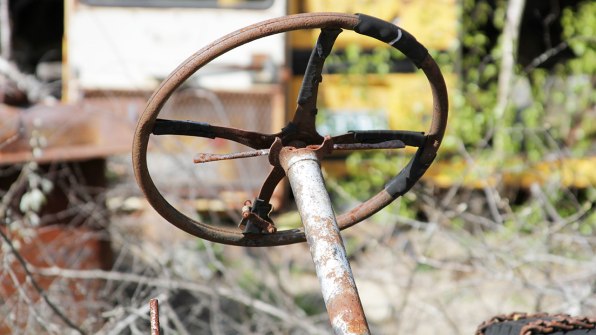How To Get Rope In Rust
The dire situation that Detroit is facing would give anyone pause: a population loss of 700,000, unemployment hovering at 20%, 40% of city lights inoperative, nearly 80,000 abandoned buildings, an average emergency response time of 58 minutes, and the highest rate of violent crime for large U.S. cities. And did I mention, Motor City just filed the largest municipal bankruptcy in American history. Urban planners, debt restructuring specialists, and corporate leaders have all thrown up their hands in frustration.
So, what should Detroit do?
Detroit is facing what its sister Rust Belt cities have experienced for decades. The problems stem from the deindustrialization of the 1970s, and the subsequent departure of large manufacturing and heavy industry.

Manufacturing may never return in large numbers, so the bigger question for Detroit and the Rust Belt is "What is our identity?"
The Rustbelt knows it has an identity crisis "People outside Wisconsin don't know what to think of Milwaukee," a Milwaukee news station reported a few years back. "Cleveland has a communication gap, not a product gap," David Gilbert from Positively Cleveland sounded off. Toledo's local leaders want find a new brand for the Glass City. And Buffalo wants people to forget that the city gave birth to the chicken wing. "It's about harnessing the power of the assets we have," said Dottie Gallagher-Cohen of Visit Buffalo Niagara.
Advertising agencies are knocking at the doors of City Halls throughout the Rust Belt. The region has become the target for extreme branding makeovers. Desperate for a solution, mayors and legislators and tourism bureaus seem only too happy to pay the multi-million dollar campaign fees. Marketing cities is nothing new, but today's campaigns are much more ambitious and costly. Visit Milwaukee had a 2012 budget of $7.6 million, Visit Pittsburgh budgeted $10.2 million, and Visit Buffalo Niagara allocated $3.3 million for its outreach.

But, how do you rebrand cities that, for over a century, defined themselves by what they manufactured? When 4 out of 10 people have no meaningful connection to the workforce, advertising expenditures make as much sense as playing the lottery. But, when there's little hope for a real economic turnaround, the lottery begins to look pretty attractive.
Effective marketing campaigns do prove useful for mobilizing a civic conversation about what's new–and what's old and can be discarded.
A quick look at Rustbelt marketing campaigns over the last few years shows remarkable diversity despite the similarity of circumstance.
Once the home of Standard Oil, Cleveland decided to target the "consumer" experience. The 2013 campaign, "Seamless Cleveland," focuses on easing transportation and making landmarks identifiable. Not kidding, it seems that tourists and residents are getting lost too often as they wander about–which one might have assumed would be a good thing since it keeps consumers milling about. Cleveland's tourism bureau, Positively Cleveland, has spent hundreds-of-thousands of dollars training bartenders, taxi cab drivers, waitresses and others to become stronger ambassadors for the city.
So far, the returns on investment are not bad. Founded in 2007, and funded principally by Cleveland's "bed tax"–literally taxes collected from people who sleep in hotels beds–Positively Cleveland helped Cayuhoga County boasts a 12% increase in spending from outside visitors–nearly $7 dollars in 2012. All this with a budget of roughly $4.2 million dollars in 2009.

Back in (the city formerly known as) "Brew City," Milwaukee has chosen the artistic route–promoting museums, late night concerts, and locally grown documentaries. In fact, the new logo for the city makes use of the Milwaukee Art Museum. "Just as the arch is a strong representative of what St. Louis is all about, the Milwaukee Art Museum is the strongest representative of what the city of Milwaukee is about right now," said Mayor Tom Barrett. Yet, the city has also sought to market itself as a hospitable working-class family vacation spot. (We love the refreshingly self-mocking promotional lines: "Milwaukee. Think of us as Chicago's Upper Upper North Side.")
Pittsburgh was faced with the similarly daunting challenge of shedding the Steel City moniker. Perhaps it was hoping for the element of surprise when it developed the "Emerald City" campaign in 2010, billing itself not as a city of toxic waste, but a pro-environment urbs in horto built on green technology. Six years ago, ads around town asked people to "Imagine Pittsburgh" anew as a technological hub. The tag line read like overcooked pasta: "Imagine what you can do here; find a job; build a life you'll love…" But the efforts seem marginally successful. Pittsburgh hosts nearly 1,500 technology firms, with companies such as Apple, Google, and Intel placing research offices in the city–several top flight, scientifically oriented universities also help.
More recently, the Steel… er, Emerald/Tech City is showing a softer side. Visit Pittsburgh, the city's official tourism promotion agency, claims "Pittsburgh is Kidsburgh," in its attempt to become family-friendly city. Pittsburgh also seems ready to shed its white ethnic image, and welcome its Latino population with a ¡Hola Pittsburgh!/¡Pittsburgh Te Invita! campaign. Launched earlier this year, ¡Hola Pittsburgh! profiles four Latinos who have opted to build their careers and live in Pittsburgh.
If there is one Rustbelt city that tears at your heart, it's Buffalo. Business and civic leaders have doggedly sought to rebrand the Nickel City for the past three decades. This could well be the Everest of Rustbelt rebranding efforts (Don't worry, I haven't forgotten about Gary, Indiana). Anyone remember the "Buffalo. We're talking proud!" campaign of the 1980s? Didn't think so. The more recent version, however, from Visit Buffalo-Niagara, similarly delivers on chutzpah.

"In developing this new brand platform, we have tried to identify and articulate the unique attributes that will distinguish Buffalo from its competitors and attract cultural tourists who are looking for authentic experiences of American history, architecture and culture," so says, Dottie Gallagher-Cohen, president and CEO of Visit Buffalo Niagara. The effort was more collaborative than most such campaigns, as it involved residents and a wide range of community stakeholders in addition to creatives.
Unfortunately, not everyone saw the promise of the campaign. Ad Age ran the headline, "Buffalo's New Tagline Highlights the Worst of Tourism Marketing."
"Buffalo. For Real" may be direct and to the point, but isn't part of the goal to take our minds away from what Buffalo really is?
We could keep going in our journey to find best (and worst) marketing strategies. Flint, Michigan, is building a new identity by celebrating small business growth, which seems feasible since big business growth all but died. Toledo flew in the face of reason by staking its claim as the center of the new manufacturing economy–though their marketing material never really tells you what that actually is. But Gary, Indiana, may receive the Grand Prix at next year's Cannes Lions Festival: It has been advertising dilapidated homes for $1 as the ticket to urban revitalization (As is, of course). Buyers are lining up–the smart ones are negotiating a lower price.
So, Detroit, you're not alone. You have options–and not all are driven by a great ad. But you'll need to rethink your current approach. To begin, changing your slogan from Motor City to America's Great Comeback City (thanks to SMZ Advertising of Troy, Michigan), doesn't really signal a direction or a value. What are you coming back to?
Perhaps you should consider the advice of economist Paul Krugman, who asks that you take a cue from Pittsburgh. More than half of the jobs in Pittsburgh are within 10 miles of the central business district, versus less than a quarter in Detroit. A concentrated approach allows Pittsburgh to use resources efficiently, while creating intimate neighborhoods with strong identities. Work on your core, Detroit. Build from the center outward by creating a smaller, livable city. I know automobiles are your legacy, but there's an idea called public transport that is worth considering.

Your economic development team will need to make priorities. There's been talk of artists and creatives flooding Motor City to catalyze the rebirth, but these folks won't rebuild your tax base. Your strength is the local unionized workforce–they're strong, well trained, dependable and certainly able to make more than cars. Retrofit these folks for a new economy.
Finally, lower your residential footprint. The miles of uninhabited areas are an eyesore, but they are also draining your government budgets. These lands could better serve light manufacturing, and a variety of new industries, from textiles to high-tech production, that are high growth areas of our economy.
And, if all else fails, I'd recommend getting into a bidding war with Gary: Give people the homes for $.50, but they have to move back to Detroit.
Sudhir Venkatesh is William B Ransford Professor at Columbia University (Twitter: @avsudhir). Venkatesh, Nicholas Occhiuto, and Carmen Ren are part of the Advertising Research Network, Columbia University.
How To Get Rope In Rust
Source: https://www.fastcompany.com/3016797/can-advertising-bring-back-the-rust-belt
Posted by: mashburnbremand.blogspot.com

0 Response to "How To Get Rope In Rust"
Post a Comment